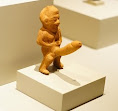Henry
James wrote a short story called “The Birthplace,” in which Morris Gedge and
his wife are chosen to be the docents in the house where William Shakespeare was
born. It’s obviously Shakespeare’s birthplace, although James never mentions
Shakespeare by name. He is always He or Him, and the people who come
to visit the birthplace are always They. Feeling privileged and personally
responsible for preserving and passing on the Truth about Him, Morris can’t
bring himself to dramatize his tours with any unsubstantiated detail, as Mrs.
Gedge, who has no such compunctions, enthusiastically does. Morris acknowledges
that he does not know precisely where in the house He was born; Morris isn’t
even sure that He was born in that house. But They are not impressed and
attendance declines. Morris is reprimanded by the higher-ups who hired him. Finally,
in danger of losing his job, he relents, and in the final scenes of the story
he concocts an elaborate picture of the childhood genius crawling around “on
the boards of this very floor!”
I
thought about this story after my wife and I had given a talk about Ephesus and
read excerpts from Life and Death in Ephesus. Four people approached us
afterwards and asked questions about the brothel. I’m much like Morris Gedge at
the beginning of James’s story. As I see it, the stories that tour guides tell
about the brothel are entirely fictitious—not only fictitious, but also
incredible, ludicrous even. There is every reason to believe that there were
brothels in Ephesus. but no reason to believe that the house identified as The Brothel
was one of them. Its reputation derives from the discovery of a tiny statuette
of the god Priapus, or maybe the Egyptian god Bes, now in the Ephesus Museum.

It’s a form of ethnocentric prudishness to suppose that public representation of an erect penis would not be found in any respectable house, that such explicit sexuality would be found only in a “house of ill repute.” Apart from the one priapic find, other artwork in the same house is asexual – much like other houses in the neighborhood.
In contrast, look at the some of the pictures found in Pompeii. There, erotic art is liberally distributred throughout the city, and in the well-documented brothel, the goings on are orgiastically represented in every room.
Having
decided that the house across the street from the Celsus Library was once a brothel,
tour guides and umpteen websites spin on to ever more fanciful detail. Graffiti
carved in the paving of a nearby street are advertisements for the brothal, give directions, and and tell
an approaching stranger, as if he didn’t already know, that you have to pay for
sex with a prostitute. Married men with a library card, however, didn’t need
directions to the brothel. They could avail themselves of a secret passageway
that connected the library and the brothel underground.

Men looked for these kind of ads when they arrived in a new city. Where are the prostitutes? Sure enough this billboard carved in the stone gave them directions. If you want the love (heart shape) of a pretty girl (image of pretty girl) turn left (left foot) at the next crossroad (T-shape). Sure enough, archaeologists found a two-story brothel up the road to the left. It was even connected by an underground tunnel to the library.
Then a voice in my ear whispers, “Lighten up, Finlay. Honestly, now, aren’t you doing the
same thing? Inventing stories about life and death in Ephesus as if they were
true? While knowing that they're not?”
And
I answer, “Ah, but what I write is literature! It’s called historical fiction! As a rule, it's true to history when the history is known, and plausible, at least, when it's not known.”
A
friend of mine was once employed as a docent in a historic house in Portland,
ME. I was much surprised when he told me that he really enjoyed telling the apocryphal stories he inherited along with the job. He’s a very good writer, an
engaging speaker, and I feel sure that he perfected his story-telling like the
artist he actually is. And that’s just where the Henry James story ends up. Morris
Gedge becomes an artist, a story-teller, and James rewards him for it.



Comments
Post a Comment